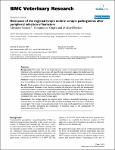Relevance of the regional lymph node in scrapie pathogenesis after peripheral infection of hamsters
Kratzel, Christine
Krüger, Dominique
Beekes, Michael
Background: The exact role of the lymphoreticular system in the spread of peripheral prion infections to the central nervous system still needs further elucidation. Against this background, the influence of the regional lymph node (Ln. popliteus) on the pathogenesis of scrapie was monitored in a hamster model of prion infection via the footpad. Methods: Surgical lymphadenectomy was carried out at different time points after infection, or prior to inoculation, in order to elucidate the impact of the lymph node on lethal neuroinvasion. Results: The Ln. popliteus did not show an influence on pathogenesis when a high dose of infectivity was administered. However, it was found to modulate the interval of time until the development of terminal scrapie in a subset of animals lymphadenectomized after low-dose infection. In additon, lymphadenectomy performed four weeks before inoculation prevented cerebral PrPTSE deposition and development of disease during the period of observation (314 days) in the majority of hamsters challenged with a very low dose of scrapie agent. Conclusion: Our findings suggest the regional lymph node as a potentially facilitating or even essential factor for invasion of the brain after peripheral challenge with low doses of infectious scrapie agent. The invasive in vivo approach pursued in this study may be applied also to other animal species for further elucidating the involvement of lymphoid tissue in the pathogenesis of experimental and natural TSEs.
Dateien zu dieser Publikation

